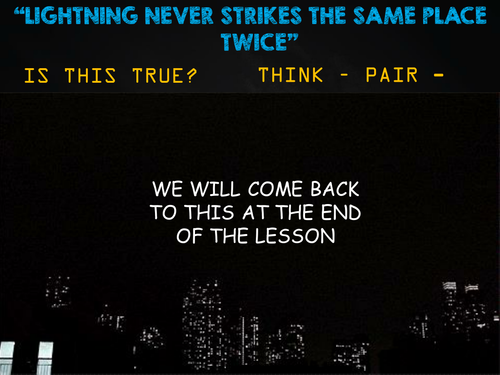

Complete AQA GCSE Physics lessons on Electric Charges and Fields.
Starter begins with discussion of a popular lightning myth/misconception which will be revisited at the end of the lesson. The structure of the atom is reviewed leading to how atoms can gain a charge and therefore how objects can become charged. The main consists of two simple experiments for pupils to do using safe and simple equipment to explore statics. Students also explore electric fields which exist around charge objects and draw these (as required by new specification)
Questions on the Van der Graaf are included with links to videos and a simulator if the teacher doesn't have access to a Van der Graaf.
Lesson is consolidated by revisiting the starter reviewing pupil knowledge and also through exam style questions based on the specification and style of sample exam papers content.
Lesson Objectives:
1) Describe the structure of the atoms. (D)
2) Explain how an atom can be ‘charged’ and how an object can have a ‘charge’ (C)
3) Investigate how charged objects interact with each other due to electric fields. (B)
4)Apply you knowledge of ‘charges’ to explain static electricity. (A)
Note: This lesson is formatted is similar content to previosuly listed 'Statics lesson' but in the new Nteach style and also with new content relevant to the new specification for AQA GCSE Physics. The lesson will be updated as all lessons are as I create new , engaging and challenging content relevant to the subject.
Starter begins with discussion of a popular lightning myth/misconception which will be revisited at the end of the lesson. The structure of the atom is reviewed leading to how atoms can gain a charge and therefore how objects can become charged. The main consists of two simple experiments for pupils to do using safe and simple equipment to explore statics. Students also explore electric fields which exist around charge objects and draw these (as required by new specification)
Questions on the Van der Graaf are included with links to videos and a simulator if the teacher doesn't have access to a Van der Graaf.
Lesson is consolidated by revisiting the starter reviewing pupil knowledge and also through exam style questions based on the specification and style of sample exam papers content.
Lesson Objectives:
1) Describe the structure of the atoms. (D)
2) Explain how an atom can be ‘charged’ and how an object can have a ‘charge’ (C)
3) Investigate how charged objects interact with each other due to electric fields. (B)
4)Apply you knowledge of ‘charges’ to explain static electricity. (A)
Note: This lesson is formatted is similar content to previosuly listed 'Statics lesson' but in the new Nteach style and also with new content relevant to the new specification for AQA GCSE Physics. The lesson will be updated as all lessons are as I create new , engaging and challenging content relevant to the subject.
Get this resource as part of a bundle and save up to 50%
A bundle is a package of resources grouped together to teach a particular topic, or a series of lessons, in one place.
Something went wrong, please try again later.
Another superb resource. Assessment, content, differentiation built in once again! I can confirm I will be a regular bundle customer!
Report this resourceto let us know if it violates our terms and conditions.
Our customer service team will review your report and will be in touch.
£3.00
